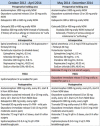Effects of Modification of Pain Protocol on Incidence of Post Operative Nausea and Vomiting
- PMID: 27990189
- PMCID: PMC5125376
- DOI: 10.2174/1874325001610010505
Effects of Modification of Pain Protocol on Incidence of Post Operative Nausea and Vomiting
Abstract
Background: A Perioperative Surgical Home (PSH) care model applies a standardized multidisciplinary approach to patient care using evidence-based medicine to modify and improve protocols. Analysis of patient outcome measures, such as postoperative nausea and vomiting (PONV), allows for refinement of existing protocols to improve patient care. We aim to compare the incidence of PONV in patients who underwent primary total joint arthroplasty before and after modification of our PSH pain protocol.
Methods: All total joint replacement PSH (TJR-PSH) patients who underwent primary THA (n=149) or TKA (n=212) in the study period were included. The modified protocol added a single dose of intravenous (IV) ketorolac given in the operating room and oxycodone immediate release orally instead of IV Hydromorphone in the Post Anesthesia Care Unit (PACU). The outcomes were (1) incidence of PONV and (2) average pain score in the PACU. We also examined the effect of primary anesthetic (spinal vs. GA) on these outcomes. The groups were compared using chi-square tests of proportions.
Results: The incidence of post-operative nausea in the PACU decreased significantly with the modified protocol (27.4% vs. 38.1%, p=0.0442). There was no difference in PONV based on choice of anesthetic or procedure. Average PACU pain scores did not differ significantly between the two protocols.
Conclusion: Simple modifications to TJR-PSH multimodal pain management protocol, with decrease in IV narcotic use, resulted in a lower incidence of postoperative nausea, without compromising average PACU pain scores. This report demonstrates the need for continuous monitoring of PSH pathways and implementation of revisions as needed.
Keywords: Multimodal pain management; Narcotics; Opioids; Perioperative surgical home; Postoperative nausea and vomiting; Total joint replacement.
Figures
Similar articles
-
Postoperative nausea and vomiting following inpatient surgeries in a teaching hospital: a retrospective database analysis.Curr Med Res Opin. 2006 Jun;22(6):1093-9. doi: 10.1185/030079906X104830. Curr Med Res Opin. 2006. PMID: 16846542 Clinical Trial.
-
Post-operative Nausea and Analgesia Following Total Mastectomy is Improved After Implementation of an Enhanced Recovery Protocol.Ann Surg Oncol. 2020 Nov;27(12):4828-4834. doi: 10.1245/s10434-020-08880-1. Epub 2020 Aug 3. Ann Surg Oncol. 2020. PMID: 32748151
-
Effects of palonosetron for prophylaxis of postoperative nausea and vomiting in high-risk patients undergoing total knee arthroplasty: A prospective, randomized, double-blind, placebo-controlled study.PLoS One. 2018 May 14;13(5):e0196388. doi: 10.1371/journal.pone.0196388. eCollection 2018. PLoS One. 2018. PMID: 29758039 Free PMC article. Clinical Trial.
-
Prevention and treatment of postoperative nausea and vomiting.Drugs. 2000 Feb;59(2):213-43. doi: 10.2165/00003495-200059020-00005. Drugs. 2000. PMID: 10730546 Review.
-
A meta-analysis of the use of nonsteroidal antiinflammatory drugs for pediatric postoperative pain.Anesth Analg. 2012 Feb;114(2):393-406. doi: 10.1213/ANE.0b013e31823d0b45. Epub 2011 Nov 21. Anesth Analg. 2012. PMID: 22104069 Review.
Cited by
-
Total knee arthroplasty: improving outcomes with a multidisciplinary approach.J Multidiscip Healthc. 2018 Jan 25;11:63-73. doi: 10.2147/JMDH.S140550. eCollection 2018. J Multidiscip Healthc. 2018. PMID: 29416347 Free PMC article. Review.
References
-
- Gan T.J., Diemunsch P., Habib A.S., Kovac A., Kranke P., Meyer T.A., Watcha M., Chung F., Angus S., Apfel C.C., Bergese S.D., Candiotti K.A., Chan M.T., Davis P.J., Hooper V.D., Lagoo-Deenadayalan S., Myles P., Nezat G., Philip B.K., Tramèr M.R., Society for Ambulatory Anesthesia Consensus guidelines for the management of postoperative nausea and vomiting. Anesth. Analg. 2014;118(1):85–113. doi: 10.1213/ANE.0000000000000002. - DOI - PubMed
-
- Chen J.J., Frame D.G., White T.J. Efficacy of ondansetron and prochlorperazine for the prevention of postoperative nausea and vomiting after total hip replacement or total knee replacement procedures: a randomized, double-blind, comparative trial. Arch. Intern. Med. 1998;158(19):2124–2128. doi: 10.1001/archinte.158.19.2124. - DOI - PubMed
LinkOut - more resources
Full Text Sources
Other Literature Sources




